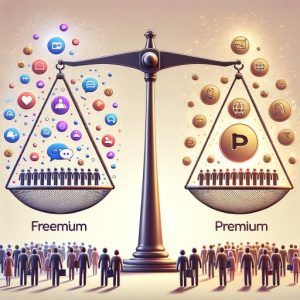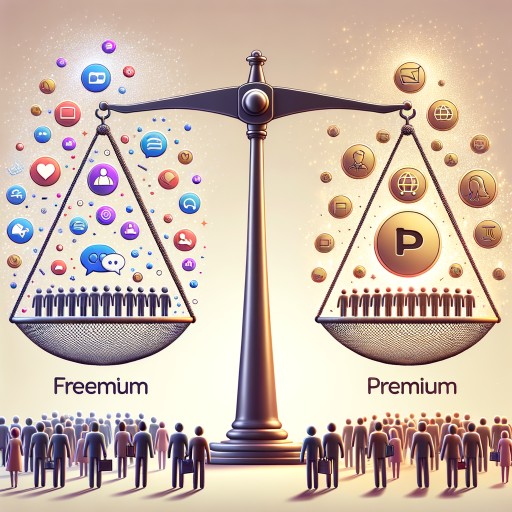Freemium or Premium: Which Strategy Best Captures Today’s Online Audience?

One of the strategic decisions that marketers grapple with is whether to adopt a freemium or premium membership model. As digital consumption habits continue to shift, the question arises: Do freemium memberships still effectively attract members, or is a premium strategy more successful in capturing today’s online audience?
And can I tempt you with a couple of Free Trials?
Freemium models have been a staple in the digital world for decades. Their fundamental promise is simple: provide basic services for free while charging for advanced features. The allure of freemium lies in its accessibility. It allows users to experience a brand’s initial offering without a financial commitment, reducing the barrier to entry. Many startups and established companies have thrived using this model, including giants like Spotify, LinkedIn, and Dropbox.
However, the freemium strategy is not without challenges. As online markets mature, users grow more discerning. The abundance of free offerings has led to heightened expectations, with users demanding significant value even from no-cost products. This shift necessitates that brands offer a compelling enough free tier to engage users without undermining the incentive to upgrade to paid plans.
Analyses of freemium models suggest that they often depend heavily on a small percentage of users converting to paid members. The “power of free” helps in building a broad user base quickly, but the sustainability of this approach hinges on how effectively brands can convert these free users into paying customers. Companies must strike a delicate balance between offering enough in the free tier to attract users, yet keeping premium features enticing enough to drive conversion rates.
On the other hand, premium models advocate for an upfront charge, offering a more predictable revenue stream from the start. Premium subscriptions often assume that users are willing to pay for immediate access to high-quality, exclusive content or features. This model presupposes a high level of trust and a strong brand reputation that can justify the commitment from potential customers.
The premium approach is particularly effective in niches where quality, exclusivity, and advanced features are highly valued—think SaaS (Software as a Service) platforms, certain streaming services, or specialized industry publications. It targets an audience that is prepared to invest in what they perceive to be superior or tailored offerings that promise to enhance their personal or professional lives.
In advancing this conversation, examining current trends provides critical insights. The digital sphere is currently characterized by an information overload. Users are presented with an overwhelming array of options, prompting more selective decision-making processes. As a result, the battle for attention has intensified, causing shifts in consumer behavior patterns.
A notable trend is the rising interest in content and services that not only provide utility but also save time and add genuine value. Thus, premium strategies that emphasize quality, exclusivity, and efficiency are gaining traction. Consumers have shown a willingness to invest in platforms that streamline their activities and offer a clear, prominent advantage over free alternatives.
Simultaneously, another prominent trend is the focus on personalization and community. Freemium models can capitalize on this by fostering a sense of belonging among free users, nudging them towards premium services by gradually demonstrating increased value. Successful freemium platforms often leverage data and analytics to tailor user experiences, making their services indispensable once the initial hook is set.
In light of these developments, the choice between freemium and premium should be guided by several key questions. Who is the target audience, and what do they value most? How competitive is the market, and what are the common user acquisition costs? How likely is it that users will transition from free to paid services?
Ultimately, succeeding with either strategy requires a deep understanding of the target audience and their preferences. For some, especially in newer markets or with innovative products, freemium remains a powerful tool for garnering early traction. For others, especially in saturated or specialized markets, a premium strategy aligns better with capturing users ready to invest in superior service.
What remains clear is that neither model is universally superior. The digital environment is too dynamic for a one-size-fits-all solution. Instead, businesses must remain agile, ready to adapt their strategies as market conditions evolve. Continual evaluation, testing, and iteration will ensure that whether choosing freemium, premium, or a hybrid approach, the strategy remains responsive to the ever-changing needs of the digital consumer.
OH – As I conclude the article, I will of course mention an offer or two of my own. 🙂
Both of which have a Free Trial to fully test my AI apps – with no committment to purchase after using the free credits included. You would of course be added to my mailing list – with the option to unsubscribe at any point.
So if you’re still here – then do check these:
Product Creation Package Idea Generator:
When you’re ready to dive into the world of digital product creation but don’t know where to start… Our AI-powered app is here to help! With just a few clicks, you can generate a wealth of product ideas tailored to your chosen niche. (Demo Video on the page along with a description of the app and it’s output.)
AI Image Crafter:
Your Creative Partner in Social Media Design, providing a seamless blend of AI-driven creativity and human intuition.
The result? Graphics that are not only tailored to your brand’s unique voice but also optimised for engagement and conversion. (Demo Video and Samples on the page, showing off the Edit & Add Text Functions.)
I hope they are useful,
and show that Quality as a Free entry point, does still attract interest.
Randy Smith
